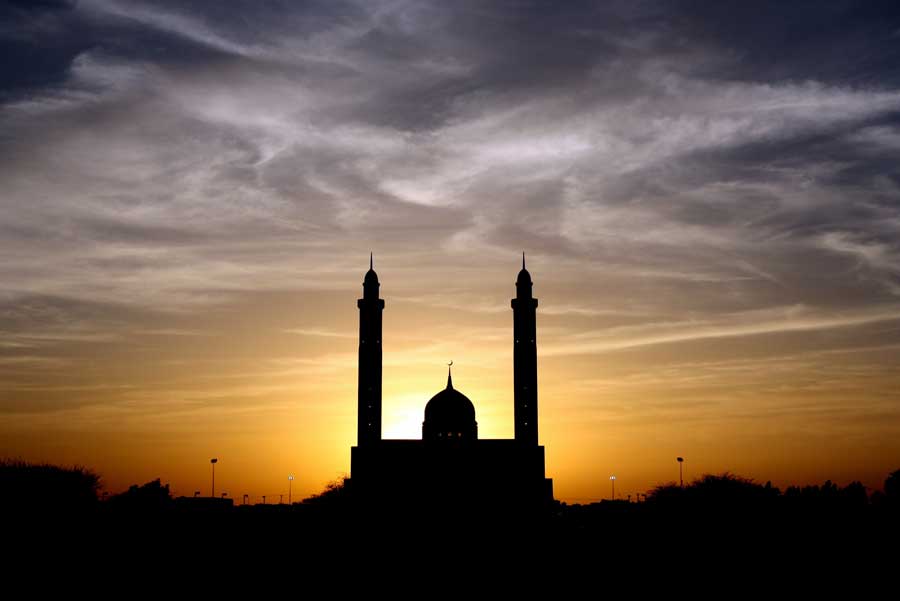The rulership of the Muslim ummah, or community of believers, has undergone significant transformations throughout the centuries. Prophet Muhammad, peace and blessings be upon him, was the leader and guide for the emerging Islamic community for twenty-three years, from 610 to 632 CE, before returning to his Lord. He achieved the mission of receiving revelation of the Qur’an, conveying the message of Islam, and calling his people to worship Allah alone. However, his death was a massive test for the believers. After his passing, they were tasked with continuing his legacy and maintaining the stability of the new Islamic state. Since then, there have been disagreements surrounding whose responsibility it was (and is) to lead the general body of Muslims. Two distinct groups emerged from these initial disputes – the Sunnis and Shias – and from the two many subgroups which have endured until modern times.
The most prominent characteristic of the early Muslim ummah, or community, was its unity in obedience to the teachings of the Prophet (s). In religious matters, they followed what was put forward by the Qur’an and the Sunnah of the Prophet Muhammad (s). They respected Prophet Muhammad’s authority, never deviating from the path he paved for them. They had direct access to this fountain of knowledge, were witnesses to the revelation of Qur’anic verses, and fought with him to establish Islam in the Arabian Peninsula.
Among the closest people to the Prophet, peace be upon him, were his family members, those who lived with him, the first converts from Makkah, and the Ansar or helpers of Madinah. The relationship between the close companions was, at the very least, civil, as they followed a code of conduct defined by the prophetic model. Abdullah ibn Salaam reported that the Prophet said, “O, people, spread peace, feed the hungry, and pray at night when people are sleeping, and you will enter Paradise in peace” (Sunan al-Tirmidhi). Spreading peace meant that they respected one another, were generous, and displayed a positive attitude. During times of conflict, they referred to the Prophet (s) for guidance or mediation.
Throughout the time of Muhammad’s prophethood, the new Muslims were united under the banner of faith. They had to face enemies who were stubbornly opposed to Islam and actively persecuted anyone who followed its message of pure monotheism. There was little room for division – a united front was necessary to defeat all opponents. Back then, the antagonists were mostly polytheists and other non-Muslim groups. Once Makkah was conquered, a general amnesty was granted to the Makkans, and of the most egregious oppressors of the Muslims, a handful were killed, and the others granted pardons. Consequently, many embraced Islam, hoping to benefit from its success.
After the Death of the Prophet (s)
Political turmoil within the Muslim community began after the death of the Prophet (s). Some senior companions, including Umar ibn al-Khattab, were stunned and even denied his passing, deduced from the traditional narration in Sahih al-Bukhari where Abu Bakr as-Siddique reprimanded those companions who suggested that the Prophet (s) had not died. He recited to them the following verse from the Qur’an: “Muḥammad is no more than a messenger. Messengers have passed away before him. So, if he were to die or be killed, would you turn back on your heels? And he who turns back on his heels will never harm Allah at all; but Allah will reward the grateful” (3:144). His reminder helped bring the general community of Muslims back to their senses. However, some late converts, especially those outside of Madinah, began to retract their decision to join the Muslims. It may have been due to wavering faith, fear that Islam would lose its stronghold in the region, or both. Nevertheless, the successors of the Prophet (s) would defeat these rebel groups and bring stability back to the ummah.
There is a hadith attributed to the Prophet Muhammad (s), in which he said:
“Prophethood will remain amongst you for as long as Allah wishes. Then Allah will remove it whenever He wishes to remove it, and there will be a caliphate upon the prophetic methodology. It will last for as long as Allah wishes it to last, then Allah will remove it whenever He wishes to remove it. Then there will be an abiding dynasty, and it will remain for as long as Allah wishes it to remain. Then Allah will remove it whenever He wishes to remove it. Then there will be tyrannical kingship, and it will remain for as long as Allah wishes it to remain. Then He will remove it whenever He wishes to remove it, and then there will be a caliphate upon the prophetic methodology” (Aḥmad).
This prediction appears to align with the events after the Prophet’s death until the present day. After his departure came twenty-nine years of rule from 632 to 661 under the “Rightly Guided Caliphs” – Abu Bakr As-Siddique, Umar ibn Al-Khattab, Uthman ibn Affan, and Ali ibn Abi Talib, may Allah be pleased with them. All four were early converts. The first three were elder converts related to the Prophet by marriage, while the last was his cousin and son-in-law and the youngest to embrace Islam. Ali ibn Abi Talib, may Allah be pleased with him, is also considered one of the first, if not the first, to embrace Islam from the Prophet’s household. Yet, it was Abu Bakr who took the reins of the community to become the successor of the Prophet (s). After a discussion with a group of Ansar, Umar ibn Al-Khattab and Abu Ubaidah ibn Al-Jarrah, another senior companion, took from Abu Bakr the pledge of allegiance. Thus, he became the Khalifatur Rasulillah – the successor of the Messenger of Allah.
This decision has proven to be a point of contention among later groups (proto-Shia) who asserted that it was Ali ibn Abi Talib’s sole right to be given the pledge for the khilafah. One piece of evidence which is cited in support of this opinion is the hadith of Ghadir Khum. Regarding the event, it is narrated that the Prophet (s) stood up and addressed the people at a well called Khum between Makkah and Madinah. After praising Allah and delivering a sermon, he said, “If I am a person’s mawla, Ali is also his mawla” (al-Tirmidhi, Musnad Ahmad ibn Hanbal, Sunan ibn Majah).
There are varying versions of this narration; both Sunni and Shia scholars agree that it is authentic, and that the incident did indeed take place. Nevertheless, there are differences of opinion regarding the context and the meaning of the Prophet’s statement. For example, according to Sunni scholars, the term mawla could mean friend, helper, guardian, ally, etc. For the Shia, the title primarily means “leader.” The Shia would thus argue that Ali ibn Abi Talib, should have become the leader of the believers, just as the Prophet Muhammad (s) was their leader. Through the centuries, scholars have debated whether it was a matter of semantics, as the word has multiple meanings. There are other points of to consider such as why very few people disputed the decision to appoint Abu Bakr As-Siddique as the khalifah after the death of the Prophet if it was evident from the statement by the Prophet that Ali ibn Abi Talib had been named the successor. Indeed, many thousands of companions witnessed this statement and if they understood it as a decree from the Prophet (s), there would have been a major outcry when Abu Bakr was appointed.
For the Sake of Unity
John McHugo writes in A Concise History of Sunnis and Shiís, that Ali ibn Abi Talib, may Allah be pleased with him, “only gave way to Abu Bakr for the sake of the unity of the community” (pg. 40). He also mentions that this attitude became a regular pattern of behavior for him because, on other occasions, “he put the harmony of the community before his own interests and ambitions” (pg. 40). Ali ibn Abi Talib, may Allah be pleased with him, was not considered a candidate for the position of khilafah until the death of Umar ibn Al-Khattab, and lost the seat to Uthman ibn Affan. He served only as an advisor under their respective rules. This selfless behavior seems to have set the precedent for some who came after him who chose quietism over fighting for political leadership, individuals such as Imam Hassan ibn Ali, may Allah be pleased with him, and the famed scholar, accepted by both Sunnis and Shias, Jafar Al-Sadiq. Ali ibn Abi Talib’s disengagement with politics would end during the latter part of the reign of Uthman ibn Affan, may Allah be pleased with him, whose political decisions caused the unrest that eventually led to his assassination. The Muslim community witnessed the emergence of the Kharijites and the party of Ali (Shiatul Ali), who supported him against Muawiyyah ibn Abi Sufyan as the legitimate khalifah after Uthman.
Since then, the ummah has been divided on the grounds of who has more right to its leadership. The death of Muawiyyah, and his naming of his son, Yazid ibn Muawiyyah, to succeed him as ruler, paved the way for the Ummayad dynasty. Other notable epochs in Islamic history stand out with key groups, such as the Fatimids, Ayyubids, Seljuks, and Mamluks, Ottomans, and modern-day Arab states, each claiming to be on the path of truth. Each of these has had its distinctive qualities and followed varying schools of thought and methodologies. Some of the most notable of the Shia political powers were the Fatimids, Buyids, Hamdanids, and Safavids. As for their beliefs, these evolved over time; different groups broke into sects, some believing that only Ali ibn Abi Talib was the imam but did not dispute anyone after that point. Other groups included Al-Hassan, Al-Husayn, and Muhammad ibn Ali (Al-Haniffiyah) in the line of leadership. Some continued down the lineage of imamate through Imam Jafar As-Sadiq (Ismailis), while the most prominent group, the Twelvers, await the return of the twelfth imam, Muḥammad ibn al-Ḥasan, whom they consider to be the awaited Mahdi. These various categorizations did not exist among the early Shia. According to McHugo, there may not have been a clear distinction between the Sunni and Shia during the time of Imam Jafar Al-Sadiq (p. 105).
Over fourteen centuries have passed since the death of Prophet Muhammad, peace and blessings be upon him, yet the Islamic world is still debating about who was the rightful heir to the leadership after his time. There are two distinct arguments, each with its compelling evidence, but ultimately the truth is with Allah. Rather than be divided, both sides must strive for peace, following the example of Ali ibn Abi Talib, may Allah be pleased with him, who dedicated his life to uphold it.






